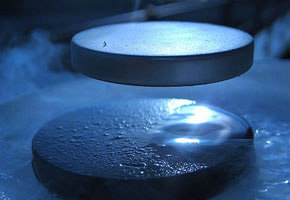

São Paulo School of Advanced Sciences on Anisotropic Conductors and Semiconductors brings together more than 60 post-graduate and post-doctoral students to dialogue with some of the top specialists in the area (Bobroff/Bouquet/LPS/WIkimedia)
São Paulo School of Advanced Sciences on Anisotropic Conductors and Semiconductors brings together more than 60 post-graduate and post-doctoral students to dialogue with some of the top specialists in the area.
São Paulo School of Advanced Sciences on Anisotropic Conductors and Semiconductors brings together more than 60 post-graduate and post-doctoral students to dialogue with some of the top specialists in the area.

São Paulo School of Advanced Sciences on Anisotropic Conductors and Semiconductors brings together more than 60 post-graduate and post-doctoral students to dialogue with some of the top specialists in the area (Bobroff/Bouquet/LPS/WIkimedia)
By Fábio de Castro
Agência FAPESP – Exactly 100 years ago, Dutch physicist Heike Kamerlingh Onnes (1853-1926) discovered the phenomenon of superconductivity, a physical property found in certain materials which at extremely low temperatures have practically zero electrical resistance.
Since then, the knowledge developed in this area has generated new superconductor materials and applications, which have more and more promising potential especially in the electro-electronic field. The most advanced research in the area today was the theme of the São Paulo Advanced Sciences School on Anisotropic Conductors and Semiconductors, held in Lorena (SP), where some of the world’s top specialists on the subject interacted with more than 60 post-doctoral and post-graduate students from Brazil and abroad.
The event, organized by the Department of Material Engineering at the Universidade de São Paulo’s Lorena Engineering School (EEL-USP), was held in August under the auspices of the São Paulo Advanced Sciences School (ESPCA or ASPAS) program, which is funded by FAPESP.
Anisotropy is a characteristic of certain substances whereby physical properties vary in accordance with direction. “Anisotropic conductors and superconductors are materials that conduct an electrical current in different manners according to direction, unlike isotropic conductors, such as copper, which conducts currents in the same manner regardless of direction,” commented course coordinator, Carlos Alberto Moreira dos Santos in an interview with Agência FAPESP.
According to the EEL-USP professor, conventional superconductors are very important in the development of modern day technologies such as electronics, high speed trains and particle accelerators. But existing knowledge about anisotropic semiconductors must be advanced.
“Anisotropic superconductors have a more complex crystalline structure. We can advance significantly in technological applications if we better understand the process of electrical conduction in these materials,” he says.
Santos explains that his group in Lorena has been working in the anisotropic conductors and superconductors area with the collaboration of researchers from abroad for roughly eight years. But, while many Brazilian students will be sent to laboratories abroad, visits by foreign researchers and students to Brazil occur on a much smaller scale.
“Today, we have strong international collaboration, especially with U.S. institutions. Due to this interaction, we realized that in addition to sending researchers abroad, we would have much to gain if we also brought foreigners to our institution. When FAPESP launched the ESPCA schools, we realized we had an excellent opportunity for internationalization,” he affirmed.
Half of the students that participated in ESPCA schools are foreigners from the United States, China, India, Mexico, Argentina, Spain and Germany. There were also participants from EEL-USP and other Brazilian institutions.
“These students are taking advantage of a unique opportunity for intense interaction with some of the most renowned area specialists from Brazil and around the globe. It is two weeks of full-time dedication. In addition to the mini-courses during which speakers make a series of presentations, there are conferences dedicated to deepening knowledge on certain topics,” says Santos.
The program also envisages meetings. “These are moments in the schedule reserved for discussions with groups outside the classroom in the attempt to broaden international relations. In this activity, the researchers can, for example, visit laboratories to verify the equipment that can be utilized in the event that these students broaden collaboration with us,” he explained.
The event also represents a unique opportunity to strengthen ties among the members of the Brazilian scientific community. “Over time, the superconductivity group in Brazil has been dispersing,” says Santos.
Although contacts are made sporadically at large physics conventions, according to the school’s coordinator, specialists in superconductivity have encountered great difficulty in meeting and interacting more closely.
“When we began to enter into contact with the most renowned specialists from the area in Brazil to hold the ESPCA, everyone realized that it would be a unique opportunity to bring the group together in one location,” he said.
Among the foreign professors invited were Zachary Fisk and Alexander Chernyshev, of the University of California Irvine (United States), John Neumeier, of Montana State University (United States), Joshua Cohn, of the University of Miami (United States), Mathias Doerr, of Institute for Experimental Physics Dresden (Germany), Milton Torikachvili, of San Diego State University (United States), Xavier Berenguer, Institute of Materials Science of Barcelona (Spain), and Gladys Nieva, of the Bariloche Atomic Center (Argentina).
More information: www.espca.eel.usp.br
Republish
The Agency FAPESP licenses news via Creative Commons (CC-BY-NC-ND) so that they can be republished free of charge and in a simple way by other digital or printed vehicles. Agência FAPESP must be credited as the source of the content being republished and the name of the reporter (if any) must be attributed. Using the HMTL button below allows compliance with these rules, detailed in Digital Republishing Policy FAPESP.





